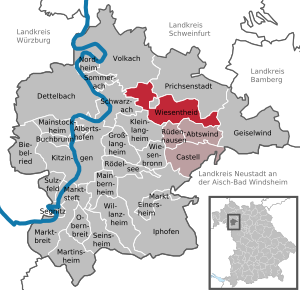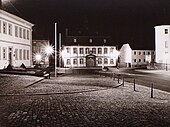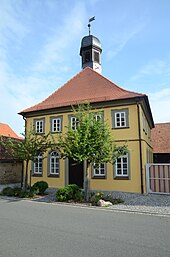Wiesentheid
| coat of arms | Germany map | |
|---|---|---|

|
Coordinates: 49 ° 48 ' N , 10 ° 21' E |
|
| Basic data | ||
| State : | Bavaria | |
| Administrative region : | Lower Franconia | |
| County : | Kitzingen | |
| Management Community : | Wiesentheid | |
| Height : | 249 m above sea level NHN | |
| Area : | 33.37 km 2 | |
| Residents: | 4834 (Dec. 31, 2019) | |
| Population density : | 145 inhabitants per km 2 | |
| Postal code : | 97353 | |
| Primaries : | 09325, 09383 | |
| License plate : | KT | |
| Community key : | 09 6 75 178 | |
| Market structure: | 10 districts | |
Market administration address : |
Balthasar-Neumann-Str. 14 97353 Wiesentheid |
|
| Website : | ||
| Mayor : | Klaus Köhler ( Free Voters ) | |
| Location of the Wiesentheid market in the Kitzingen district | ||
Wiesentheid is a market in the Lower Franconian district of Kitzingen and the seat of the Wiesentheid administrative community .
location
Wiesentheid is located in the Würzburg region (Bavarian planning region 2). The Sambach (Castellbach) and the Fasanenbach flow through the village .
Community structure
There are ten districts:
- Feuerbach
- Fuchsenmühle
- Geesdorf
- Upper paper mill
- Obersambach
- Reupelsdorf
- Lower paper mill
- Untersambach
- Untersambacher mill
- Wiesentheid
There are the districts of Feuerbach, Geesdorf, Reupelsdorf, Untersambach and Wiesentheid.
Neighboring communities
Neighboring communities are (starting from the north in a clockwise direction): Volkach , Prichsenstadt , Geiselwind , Abtswind , Rüdenhausen , Kleinlangheim and Schwarzach am Main .
Natural location
Wiesentheid and its districts are naturally located in the Steigerwald foreland . Wiesentheid itself is located in the so-called Keuperland step, which is characterized by several 10 to 20 m deep valley cuts. The ascent towards the steep slopes begins in the east. Large parts of the municipality can be found in the Schwanberg foreland with its small hills. To the west of Reupelsdorf is the Dimbacher drift sand area , which is much flatter in the direction of the Main.
history
In 918 the place was first mentioned as "wiesenheida". Wiesentheid was formerly the seat of the imperial direct rule Wiesentheid . It was founded in 1681 by Prince-Bishop Peter Philipp von Dernbach zu Bamberg and Würzburg with the support of Emperor Leopold. The first owner of the rule was the nephew of the prince-bishop, Johann Otto von Dernbach zu Wiesentheid, Lord of Arnfels in Styria and Wallenfels in Carinthia, an imperial and really secret councilor and chamberlain, hereditary marshal of the Duchy of Franconia († 1697). His first two wives died and so did their children. Sensing his death, he set his third wife, Eleonore Charlotte nee. Countess von Hatzfeld -leichen, as sole heir. The rule of Wiesentheid passed through her to Count Rudolf Franz Erwein von Schönborn , whom she married in 1701. The rule lay in the Franconian Empire and was mediatized by Bavaria in 1806 , ceded by this in the course of border adjustments to the Grand Duchy of Würzburg , with which it finally fell back to the Kingdom of Bavaria in 1814.
In the years from 1614 to 1617 Wiesentheid was the scene of 91 witch trials, in 1617 four women and one man were executed on the local Trudenplätzlein. One of the greatest witch burners in Franconia , Johann Georg II. Fuchs von Dornheim , was born in Wiesentheid Castle.
Desolations and incorporations
The Hertrichshausen desert is localized in the literature in the settlement triangle Wiesentheid, Obersambach and Gräfenneuses. The settlement was probably abandoned in the 14th century. In the course of the administrative reforms in the Kingdom of Bavaria , today's municipality was created with the municipal edict of 1818 . Until June 30, 1972 Wiesentheid belonged to the Gerolzhofen district , which was dissolved during the district reform . On July 1, 1972, the previously independent municipality of Reupelsdorf was incorporated. Geesdorf was added on January 1, 1977. Feuerbach followed on January 1, 1978 and Untersambach on May 1, 1978.
Population development
- 1961: 3153 inhabitants
- 1970: 3476 inhabitants
- 1987: 3806 inhabitants
- 1991: 4032 inhabitants
- 1995: 4,338 inhabitants
- 2000: 4696 inhabitants
- 2005: 4815 inhabitants
- 2007: 4844 inhabitants
- 2008: 4810 inhabitants
- 2009: 4733 inhabitants
- 2010: 4764 inhabitants
- 2011: 4690 inhabitants
- 2012: 4687 inhabitants
- 2013: 4719 inhabitants
- 2014: 4777 inhabitants
- 2015: 4775 inhabitants
- 2016: 4797 inhabitants
- 2017: 4840 inhabitants
- 2018: 4820 inhabitants
politics
Klaus Köhler has been mayor since May 2020, he was elected on March 15, 2020 with 50.2% of the valid votes. His predecessor was Werner Knaier (CSU) from May 2008 to April 2020.
The 16 seats in the municipal council (excluding the mayor) are distributed as follows after the municipal council election on March 15, 2020 :
- CSU : 4
- SPD : 1
- Alliance 90 the Greens: 1
- Citizens' Block (Free Voters): 6
- Citizens' Association Geesdorf: 1
- Christian voter community: 1
- FWF: 1
- WOW - boy list: 1
The tax revenues amounted in 2014 6,322,639.07 €, of which 3,040,199.87 € business taxes.
The total budget for 2014 is € 14,144,904.74, including an investment volume of around € 5,406,527.23.
coat of arms
| Blazon : “Against a blue sky on a green meadow, three stalks of red heather growing out of a silver hill; in front of it a golden lion, double-tailed and with a blue crown. " | |
| Justification for the coat of arms: The figures of heather and meadow are supposed to symbolize the place name Wiesentheid. The lion, on the other hand, refers to the Counts of Schönborn, who still live in Wiesentheid today. Your coat of arms also shows a striding lion. |
Town twinning
- {Wiesentheid has had a lively partnership with the French community of Rouillac in the Charente department since 1972 . By 2008, under the direction of the partnership committee and the local schools and associations, over 50 official and countless private meetings took place.
- On April 29, 2008, Former Mayor Walter Hahn signed a declaration of friendship with the city of Hagenbach in the Palatinate as the last official act . Many residents of Hagenbach stayed with families in Wiesentheid during the Second World War .
Culture and sights
Architectural monuments
- Counts Schönborn 'sches Schloss Wiesentheid
- Kanzleistraße with historical administration buildings
- Baroque town hall
- Castle Park
- Catholic parish church of St Mauritius by Balthasar Neumann
- Historic rectory
- Crucifixion group by Jacob van der Auvera
- Historic Marian column on the listed Marienplatz
- Kreuzkapelle (burial place of the Counts Schönborn family)
Say
The Heimbach
Many legends in Wiesentheid revolve around the so -called Heimbach or Hainbach , which runs between the market and Rüdenhausen and also crosses the so-called Heimbachtannig.
A long time ago, the noble-free Mattonen lived in nearby Dettelbach , who founded many monasteries in the area and thus promoted Christianization . So they had also settled monks in the place "Wisenhaida". Nonetheless, the old belief was still deeply rooted in the common population, but the forest women who knew magic had to withdraw ever deeper into the woods and thus also into Heimbachtannig.
Mattone from Dettelbach had only one son, who suddenly fell ill and quickly lost his eyesight . The father tried everything to help the son. After nothing had helped, a servant remembered the wise woman in Heimbachtannig, who knew how to use the eye water of the brook. So the Christian brought his child before the heathen , who made him a drink made of toad skin and herbs with the water of the Heimbach.
The child recovered noticeably through the treatment with the brew and was able to return to the castle in Dettelbach healthy after a few weeks . The Mattone then moved a ban mile around the forest. Although he now fought against the last representatives of paganism all over the area and Christianity spread quickly, the old woman in the forest remained undisturbed and was allowed to keep her faith in the old gods.
A treasure find
In the gardens near Feuerbacher Strasse, the gardeners are said to have seen a large fire again and again. Several mysterious men are said to have stood next to them with books. A well was to be dug in one of the gardens . After going very deep, beautiful ashes were discovered . But when you wanted to catch it to fertilize with it, it turned into money.
The lag
The parcel Lag to the west of Abtswinder Straße consists of a small forest and several fields on the road. Many legends are said to have happened here. It was said that the so-called lag fox was walking around there. The hunters didn't shoot him because they were afraid of the fox's curses. The Lagfuchs ate also the girls who were feeding the animals here, the snack from the baskets.
Once, when a girl was grazing her cattle in the lagoon, a headless rider suddenly rode out of the forest. He circled the herd and was soon gone. A farmer lost his herd of cows in the lagoon. When he had fetched people from Wiesentheid to look for the cows, the animals had returned. Sometimes an enchanted seventh would appear in the lagoon and visit the shepherds without a head.
Economy and Infrastructure

Economy including agriculture and forestry
In 1998, according to official statistics , there were 83 employees in the field of agriculture and forestry , 598 in the manufacturing sector and 360 in the trade and transport sector. In other economic sectors, 444 people were employed at the place of work subject to social security contributions. Social insurance contributions at place of residence, there was 1554. In the manufacturing sector there were 80 enterprises in the construction of five plants . In addition, there were 58 farms in 1999 with an agricultural area of 2016 hectares, of which 1,720 hectares were arable land and 246 hectares were permanent green space. In Wiesentheid there is also one of the main offices of the Raiffeisenbank Volkacher Mainschleife - Wiesentheid .
The Kräuter Mix GmbH has its second headquarters in Wiesentheid. There the herbs are cleaned, cut, ground and mixed. Extensive warehousing ensures high product availability for all seasonal herbs. The Göpfert Maschinen GmbH is a global leader in engineering for the processing of corrugated cardboard .
traffic
Road traffic
Wiesentheid is located at the Wiesentheid-Rüdenhausen motorway exit ( A 3 ). In addition, the market is affected to the east by federal highway 286 . Omnibusverkehr Franken GmbH provides bus connections in public transport as part of the Mainfranken transport company: From Kitzingen with the two lines 8111 (via Rödelsee ) and 8150 (via Gerolzhofen ), which run regularly on weekdays , partly included in the DB tariff , and from Bimbach (8217) , Ebrach (8163), Münsterschwarzach (8115) and Volkach (8287) with a handful of other, seldom used lines.
Kitzingen-Schweinfurt railway line
At the end of the 19th century, Wiesentheid was connected to the Bavarian railway network. In 1893 the Kitzingen- Gerolzhofen section of the so-called Steigerwaldbahn (also Untere Steigerwaldbahn) was completed, Wiesentheid was equipped with a train station. The branch line connected from 1903 Kitzingen with the Schweinfurt Hauptbahnhof and was one of the longer branch lines in Germany.
Traffic on the route began to be reduced in the 1980s. In 1981 only passenger buses drove between Gerolzhofen and Kitzingen, freight traffic was given up in mid-2006. For a long time there have been initiatives to reactivate passenger traffic on the disused route. At the beginning of 2019 a fierce dispute broke out over the design of the restart, which has continued to this day, which became a political issue .
Hiking trails
The Franconian Marienweg runs through Wiesentheid .
education
In 2015 the following institutions existed:
- Two kindergartens with a total of 168 kindergarten and crèche places
- An elementary school with an M-train with 49 teachers and 591 students
- High schools : Steigerwald-Landschulheim Wiesentheid (with boarding school ) with 61 teachers and 735 students , 173 of them in boarding school (as of September 2014)
Parishes
- Catholic rectory, St. Mauritius (Wiesentheid)
- Evangelical rectory, Gnadenkirche (Wiesentheid) , Evangelical Lutheran parish church in Feuerbach, former town hall (1751)
Personalities
- Gottfried von Seinsheim (around 1132–1213), abbot of the Münsterschwarzach monastery (1182 / 1183–1213), born in Reupelsdorf
- Johann Georg II. Fuchs von Dornheim (1586–1633), Prince-Bishop of Bamberg and campaigner for the Counter-Reformation and ruthless witch hunter ("witch burner")
- Johannes Seiz (1717–1779) born in Wiesentheid court architect in the Electorate of Trier
- Erwein von der Leyen (1798–1879), Prince von der Leyen
- Josef von Schmitt (1817–1890), judge in Bavaria, president of the Augsburg Higher Regional Court
- Valentin Ritter von Reißenbach (1839–1893), Ministerialrat, Secretary General in Munich
- Johann Thaler (1847–1920), lawyer, member of the Reichstag
- Carl Stumpf (1848–1936), philosopher, psychologist and music researcher
- Clemens von und zu Franckenstein (1875–1942), composer
- Nikolaus Fey (1881–1956), Franconian dialect poet
- Ernst Unbehauen (1899–1980), painter from Rothenburg, Unbehauen had his studio in Schloss Wiesentheid from 1945 to 1953 and lived there for a time
- Otto Weiglein (1912–1998), Bavarian politician (CSU), member of the Bavarian state parliament, honorary citizen
- Otto Hünnerkopf (* 1951), Bavarian politician (CSU), member of the Bavarian state parliament
- Angelika Weikert (* 1954), Bavarian politician (SPD), member of the Bavarian state parliament
literature
- Hans Bauer: Old and new coats of arms in the Kitzingen district . In: Yearbook of the district of Kitzingen 1980. In the spell of the Schwanberg . Kitzingen 1980. pp. 53-70.
- Ulrich Emmert: Explanations for the geological map of Bavaria 1: 25,000. Sheet No. 6228 Wiesentheid . Munich 1965.
- Johann Ludwig Klarmann: The Steigerwald in the past. A contribution to Franconian cultural studies . Gerolzhofen 2 1909
- Johann Ludwig Klarmann, Karl Spiegel: Legends and sketches from the Steigerwald. Reprint of the 1912 edition . Neustadt an der Aisch 1982
- Theophil Steinbrenner, Gerhard Wahler, Auguste Steinberger, Felix von Fokczynski (eds.): Intermediate lights. Traditional stories from the old county of Castell . Albertshofen² 1979
Web links
- www.wiesentheid.de - Wiesentheid website
- Parish Church of St Mauritius
- Entry on Wiesentheid's coat of arms in the database of the House of Bavarian History
Individual evidence
- ↑ "Data 2" sheet, Statistical Report A1200C 202041 Population of the municipalities, districts and administrative districts 1st quarter 2020 (population based on the 2011 census) ( help ).
- ↑ http://www.bayerische-landesbibliothek-online.de/orte/ortssuche_action.html ? Anzeige=voll&modus=automat&tempus=+20111114/183628&attr=OBJ&val= 1677
- ↑ Emmert, Ulrich: Explanations of the Geological Map of Bavaria 1: 25,000 . P. 7.
- ^ Wilhelm Volkert (ed.): Handbook of Bavarian offices, communities and courts 1799–1980 . CH Beck, Munich 1983, ISBN 3-406-09669-7 , p. 472 .
- ↑ a b c Federal Statistical Office (ed.): Historical municipality directory for the Federal Republic of Germany. Name, border and key number changes in municipalities, counties and administrative districts from May 27, 1970 to December 31, 1982 . W. Kohlhammer GmbH, Stuttgart / Mainz 1983, ISBN 3-17-003263-1 , p. 747 and 748 .
- ↑ http://www.wahlen.bayern.de/kommunalwahlen/
- ↑ MainPost on the 2014 budget
- ^ Bauer, Hans: Old and new coats of arms in the district of Kitzingen . P. 69.
- ↑ Expression of friendship to the market town of Wiesentheid ( Memento of the original from October 20, 2013 in the Internet Archive ) Info: The archive link was inserted automatically and has not yet been checked. Please check the original and archive link according to the instructions and then remove this notice. , City of Hagenbach, accessed on October 23, 2013
- ↑ Steinbrenner, Theophil: Zwischerlichten . P. 19 f.
- ↑ Klarmann, Johann Ludwig (among others): Legends and sketches from the Steigerwald . P. 203.
- ↑ mainpost.de: By train through the inner city of Schweinfurt, August 2, 2019. Accessed on January 19, 2020 .
- ↑ mainpost.de: IHK: Steigerwaldbahn would strengthen the region, July 20, 2018. Accessed on January 20, 2020 .
- ↑ School directory ( Memento of the original from May 27, 2015 in the Internet Archive ) Info: The archive link was inserted automatically and has not yet been checked. Please check the original and archive link according to the instructions and then remove this notice.
- ↑ Klarmann, Johann Ludwig: The Steigerwald in the past . P. 215.











